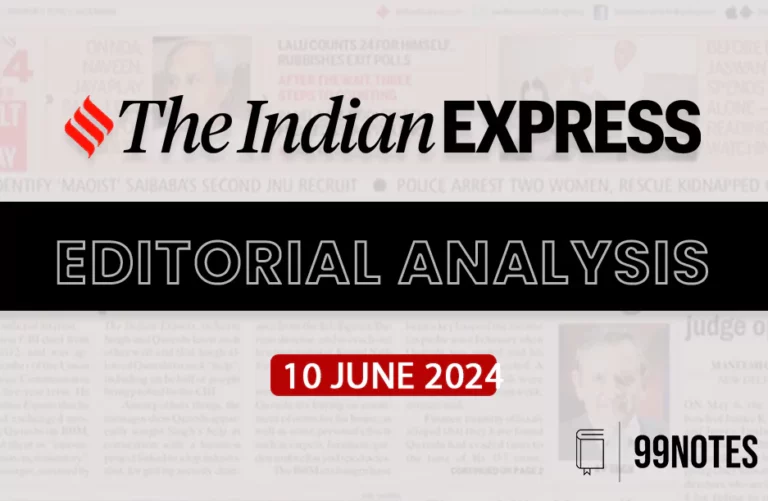4 March 2024 : Indian Express Editorial Analysis
Indian Express Editorial Analysis
4-March-2024
1. A fair deal for farmers
| Topic: GS2 – Governance – Government policies – Interventions for development in various sectors GS3 – Agriculture – MSP This topic is relevant for both Prelims and Mains in the context of understanding the economic policies surrounding agriculture, including MSP, MGNREGA, and their implications. |
| Context: |
|
Implications of Increased MSP:
- If the government accepts the proposed formula of Cost C2+50 percent for determining MSP, calculations suggest an average increase of 25 percent in MSP levels for 23 crops over the 2023-24 rates.
- While specific crops will experience varied MSP increases, such as safflower witnessing a 40 percent rise and sugarcane only 3 percent, these adjustments may prompt shifts in cropping patterns.
- Notably, wheat and sugarcane could witness a decrease in cultivation area, while surplus production of paddy may escalate, potentially necessitating higher MSP hikes for wheat and sugarcane beyond the proposed formula.
- Additionally, price escalations in essential feed materials like soybean and maize could inflate livestock and fishery product costs, contributing to heightened food inflation.
- The legal and stable MSPs for 23 crops might attract horticulture producers, potentially leading to shortages in fruits and vegetables, further exacerbating inflation in this sector.
Challenges of Legalizing MSP:
- Legalizing MSPs poses challenges, particularly for crops like rice, which could experience a 31 percent MSP increase under the new formula.
- This surge may render rice exports unviable, leading to domestic supply surpluses.
- Consequently, paddy could substitute other crops, causing a glut in the domestic market.
- The government’s ability to manage excess supplies and the fiscal implications of deficiency payments remain uncertain.
Limited Impact of MSP Segment:
- Despite the significance of MSPs for 23 crops, they constitute less than 28 percent of agricultural output.
- The majority of agricultural produce faces market prices, with segments such as poultry, eggs, fisheries, and horticulture demonstrating robust growth rates without extensive government intervention.
Implications of MGNREGA Demand:
- The farmers’ demand for a minimum of 200 days of employment under MGNREGA at a wage rate of Rs700 per day presents a substantial fiscal burden for the government.
- The estimated budgeted amount for this demand exceeds Rs10.4 lakh crore, posing challenges for a central budget of around Rs47 lakh crore.
Policy Recommendations:
- To address farmers’ grievances and ensure fair pricing for their produce, policy changes are necessary.
- These include removing export controls and stocking limits on traders, as well as halting the unloading of rice and wheat below economic costs.
- Additionally, the government should enhance futures markets, options, and warehouse receipt systems while encouraging Farmer Producer Organizations (FPOs) to participate in organized value chains on digital platforms.
- Government intervention should occur only in cases of sudden price crashes, utilizing stabilizing funds as a last resort.
Conclusion:
- The demands put forth by protesting farmers carry significant economic implications.
- While sympathizing with their plight, it’s crucial to acknowledge the feasibility challenges these demands pose to the government’s budget and broader economic stability.
- Addressing farmers’ concerns requires a balanced approach, focusing on market reforms, and prudent fiscal management.
- Rational discussions on these issues are imperative post-elections to chart a sustainable path forward.
| What is the Minimum Support Price (MSP)? |
About:
Crops Under MSP:
The list of crops is as follows:
|
| PYQ: Consider the following statements: (2020) 1) In the case of all cereals, pulses and oil-seeds, the procurement at Minimum Support Price (MSP) is unlimited in any State/UT of India. 2) In the case of cereals and pulses, the MSP is fixed in any State/UT at a level to which the market price will never rise. Which of the statements given above is/are correct? (a) 1 only (b) 2 only (c) Both 1 and 2 (d) Neither 1 nor 2 Ans: D |
| Practice Question: Discuss the economic implications of the demands put forward by protesting farmers, focusing on the proposed increase in Minimum Support Price (MSP) and the extension of benefits under the Mahatma Gandhi National Rural Employment Guarantee Act (MGNREGA). Analyze the potential challenges and benefits associated with these demands, and suggest policy measures to address the concerns of farmers while ensuring fiscal prudence and sustainable economic growth. (250 words/15 m) |
2. Going places by train
| Topic: GS2 – International Relations – India and its neighbourhood This topic is relevant for both Prelims and Mains in the context of understanding the significance of railway projects in fostering economic growth and regional cooperation. |
| Context: |
|
Railway Connectivity as a Catalyst for Economic Development:
- Railway connectivity plays a pivotal role in the economic development of the BBIN region, offering promising opportunities for collective growth.
- The BBIN initiative stands out due to its emphasis on regional connectivity and the potential to significantly reduce transportation costs as a percentage of GDP, thereby boosting overall development.
- Specific examples, such as rerouting freight trains and providing landlocked countries like Nepal and Bhutan access to ports via railways, highlight the transformative impact of enhanced connectivity on regional economies.
Bilateral Commitments and Practical Implementation:
- The success of the BBIN initiative rests on strong bilateral commitments and the practical implementation of shared infrastructure plans.
- Notably, the initiative has progressed from mere conceptualization to tangible infrastructure projects on the ground, underscoring its ambitious yet practical nature.
- Key to its success is the establishment of a seamless broad/dual gauge rail network connecting the region, alongside time-bound completion of infrastructure projects and non-physical/institutional frameworks.
Current Projects and Future Prospects:
- Existing and planned railway projects between India, Bangladesh, Bhutan, and Nepal demonstrate significant progress towards enhancing regional connectivity.
- Specific initiatives such as the Tongi-Akhaura line dual gauging and the Agartala-Akhaura rail link inauguration illustrate the tangible steps taken towards realizing the BBIN vision.
- Furthermore, ongoing survey projects and cross-border rail links signify the region’s commitment to fostering deeper economic integration through railway connectivity.
Challenges and the Way Forward:
- While physical infrastructure development is crucial, institutional arrangements and cross-border operating protocols are equally essential to ensure seamless railway connectivity in the BBIN region.
- The need for umbrella regional agreements, standardized operating procedures, and regulatory frameworks underscores the complexity of cross-border projects.
- However, addressing these challenges is imperative for realizing the full potential of railway connectivity in driving regional growth and strategic cooperation.
Conclusion: Railway Connectivity as a Pathway for Regional Growth:
- Railway connectivity serves as a vital catalyst for economic development in the BBIN region, facilitating enhanced trade, mobility, and cooperation among member countries.
- While significant progress has been made, addressing institutional challenges and fostering deeper regional cooperation are essential for unlocking the full potential of railway connectivity in driving sustainable development and prosperity across the BBIN quadrangle.
| About Bangladesh-Bhutan-India-Nepal (BBIN) initiative |
About BBIN MVA:
Objective:
Benefits:
Assistance from ADB:
|
| PYQ: In the Mekong-Ganga Cooperation, an initiative of six countries, which of the following is/are not a participant/ participants? (2015) 1) Bangladesh 2) Cambodia 3) China 4) Myanmar 5) Thailand Select the correct answer using the code given below: (a) 1 only (b) 2, 3 and 4 (c) 1 and 3 (d) 1, 2 and 5 Ans: (c) |
| Practice Question: Discuss the significance of railway connectivity projects in the BBIN (Bangladesh, Bhutan, India, Nepal) region for fostering regional cooperation, economic development, and strategic partnerships. Suggest measures to address the challenges and maximize the benefits of enhanced railway connectivity in the BBIN region. (250 words/15 m) |
For Enquiry

4 March 2024 : The Hindu Editorial Notes PDF

4 March 2024 : PIB Summary for UPSC

4 March 2024 : Indian Express Editorial Analysis

2 Mar 2024 : Daily Current Affairs Quiz

2 Mar 2024 : Daily Answer Writing

2 March 2024 : Daily Current Affairs

2 March 2024 : The Hindu Editorial Notes PDF

2 March 2024 : PIB Summary for UPSC

2 March 2024 : Indian Express Editorial Analysis

1 Mar 2024 : Daily Current Affairs Quiz
March – The Hindu Editorial 4 March 2024 : The Hindu Editorial Notes PDF The Hindu Editorial
4-March-2024
1. Mountains of plastic are choking the Himalayan States
Topic:…
March 2024 PIB 4 March 2024 : PIB Summary for UPSC PIB Summary for UPSC
4-March -2024
1. The Union Ministry of Home Affairs releases three videos about…
Indian Express 4 March 2024 : Indian Express Editorial Analysis Indian Express Editorial Analysis
4-March-2024
1. A fair deal for farmers
Topic: GS2 – Governance…
Daily Quiz 2 Mar 2024 : Daily Current Affairs Quiz 2 Mar 2024 : Daily Quiz…
mains answer writing 2 Mar 2024 : Daily Answer Writing Mains Answer Writing
2-March-2024
Q1) Is the National Commission for Protection of Child Rights (NCPCR)…
Daily Current Affairs 2 March 2024 : Daily Current Affairs Daily Current Affairs
2-March -2024- Top News of the Day
1. Supreme Court Ruling Upholds Judicial Discretion…
March – The Hindu Editorial 2 March 2024 : The Hindu Editorial Notes PDF The Hindu Editorial
2-March-2024
1. Change and continuity in India’s Palestine policy
Topic: GS2…
PIB 2 March 2024 : PIB Summary for UPSC PIB Summary for UPSC
2-March -2024
1. INDIA – MALAYSIA BILATERAL MARITIME EXERCISE SAMUDRA LAKSAMANA
Topic:…
Indian Express 2 March 2024 : Indian Express Editorial Analysis Indian Express Editorial Analysis
2-March-2024
1. Blue water power
Topic: GS2 – International Relations…
Daily Quiz 1 Mar 2024 : Daily Current Affairs Quiz 1 Mar 2024 : Daily Quiz…





